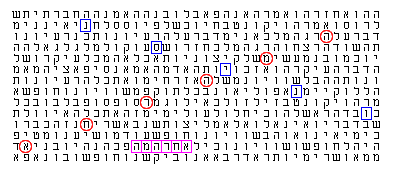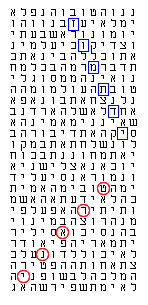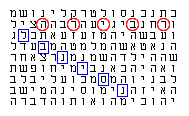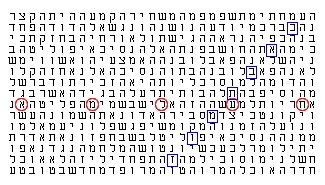
The convergence of hmhrc"a and his date of death, v nys`, in War and Peace.

|
The convergence of erany and his date of death, y"d tmvz, in War and Peace. |

The convergence of hryb"r and his date of death, l bnys`, in War and Peace.
We note that there may be a case for removing the name imdy` altogether, for it is just the name of a town were the Yaabez was briefly a Rabbi, and not his last name. The Yaabez himself wrote in [Ya],
(kawr iwh mk"t adris i"g hagrt kmv whrgyl htvib wr"y bpy
hbryvt) ydvi waynny mbny imdy` la nvld bh vla mxph lravt' aj
mbqw evbt' vtvilt' kmaz vmqdo bhyvty rvbu tct mwah, kkh ith
any wvqd il tqnt'...
... The busy Yaakov Israel known as Yaabez good omen was never called Yaakov Emdyn (imdy`) (as has done the honourable in the address on this letter as is the deplorable habit in the tongues of the people). It is known I am not from the people of Emdyn, was not born there, do not expect to see it, but am looking after its welfare and benefit as in the former times when I was under it's load, [and] so also am I now diligent for it's remedy. ...Little did his plea help, and the Yaabez has several common appellations which are variants of the word imdy`. We keep them in our list.
At this point we got the advice of two wise men. One suggested that we look at [Hei], a book on the Jewish laws in the state of Moravia, where Rabbi Menachem Mendel was the state's Rabbi. From the other wise man we learned to check the citations in the footnotes. One footnote, on page 111 of [Hei], he checked himself. It lead to an article [Marx], that contain a letter written by the son of a nephew of Rabbi Menachem Mendel in the late 17th century, only a few dozen years after Rabbi Menachem Mendel died in 1661. In that letter Rabbi Menachem Mendel's surname is given as qracmal. The following day (and a continent away), we checked the footnote on page 102. It lead us to two articles, [Har] and [Ka], devoted to our Rabbi and his descendents. Both articles use the spelling qrakmal extensively and not just in passing, and the latter one even explains where the name comes from! It relates the name qrakmal to a certain earlier Dayan, Rabbi Jonah Krochmals in the city of Cracow, where Rabbi Menachem Mendel was born. A transcript of the tombstone of Rabbi Jonah Krochmals is given in [Zo, page 180] and Krochmals is spelled qrakmalw there. Thus there is no doubt that the original spelling of the name Krochmal is qrakmal and we remove the appellation qrvkml from our list, putting qrakmal instead.
Note that here we corrected new to old, while in the case of Rabbi II-25, Rabbi Yitshak HaLevi Horowitz we corrected old to new. Whatever inconsistencies WRR have we are allowed to have too.
We also note that once it is clear that qrakmal is an acceptable spelling for Krochmal, the usage of this spelling is mandatory according to the WRR rules, which state explicitly that Yiddish names are spelled as in the original Yiddish. Recall that qrakmal is a Yiddish word.
The story doesn't end there. When we tried to find a"c hi"r as a signature in Rabbi Ricchi's books, we failed. What we did find was a different permutation of these letters, ahi"cr, which appears with its expansion, any hxiyr imnval cy ryqy (me the young, Immanuel Hai Ricchi). We note that in Hebrew the latter expansion makes much more sense than the former, and that the dictionary of acronyms [AY] lists the latter acronym but not the former. Including "ahi"cr" as an appellation is senseless for the same reasons as above, but it still makes more sense than including "a"c hi"r". So we deleted "a"c hi"r" and inserted "ahi"cr".
After the first version of this note was widely circulated, we finally found a single reference to the variation a"c hi"r, in [Shi]. That source refers to an acronym that appears as a signature on an addendum, only available in Zurich, to Rabbi Ricchi's book "miwh cvwb". Neither the original edition of that book, nor any of his other books that we checked, contain that acronym; the original edition of "miwh cvwb", like many of Rabbi Ricchi's other books, contains ahi"cr. We don't have the resources to check the manuscript in Zurich, so at the moment we don't know if the acronym a"c hi"r really appears there or if [Shi] copied it with the c misplaced. However, we can see two things clearly: if the acronym a"c hi"r exists at all it is a signature and not an appellation, and the WRR claim to have admitted only widely used pronounced acronyms is false.

The convergence of cilma and his date of death, k"a btmvz, in War and Peace.